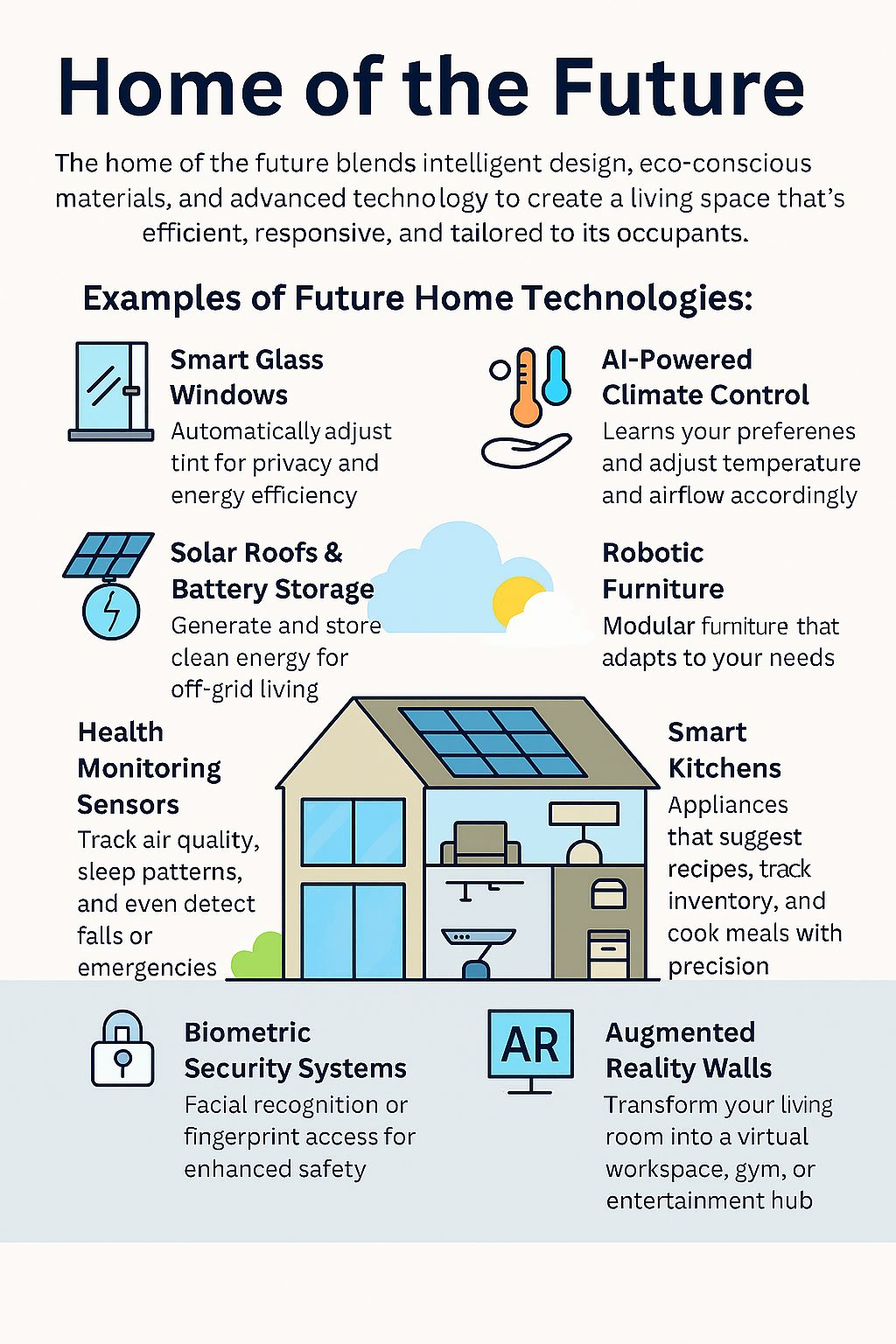How Connected Is Your Home?
The “Home Of The Future” is a smart, sustainable, and highly personalized living space designed to enhance comfort, efficiency, and well-being; while integrating advanced technologies. The “concept brings a wide range of benefits that align with evolving lifestyles, technological advancements, and environmental priorities. Here are some key advantages:
- Smart automation for lighting, climate control, and security
- Voice/gesture interfaces – seamless interaction
- Energy-efficient systems powered by solar panels and battery storage
- Modular and adaptive design that evolves with the occupants’ needs
- Eco-friendly materials and water-saving features
- AI-driven personalization learning routines and preferences
Areas Of Benefits As Observed Today:
- Smart Glass Windows – Automatically adjust tint for privacy and energy efficiency.
- AI-Powered Climate Control – Learns preferences and adjusts temperature and airflow accordingly.
- Voice & Gesture Interfaces – Control lights, appliances, and entertainment systems with simple commands or hand movements.
- Solar Roofs & Battery Storage – Generate and store clean energy for off-grid living.
- Water Recycling Systems – Reuse greywater for irrigation and reduce waste.
- Robotic Furniture – Modular furniture adapting to your needs, like beds folding into walls, tables automatically expand.
- Health Monitoring Sensors – Track air quality, sleep patterns, detect falls or emergencies.
- Smart Kitchens – Appliances that suggest recipes, track inventory, cooks meals w/ precision.
- Biometric Security Systems – Facial recognition or fingerprint access for enhanced safety.
- Augmented Reality Walls – Living room transforming into a virtual workspace, gym, or entertainment hub.
Examples Include
-
1. Smart Technology Integration
- AI-Powered Automation: Homes will learn your habits and automate tasks like adjusting lighting, temperature, and even brewing coffee at your preferred time.
- Voice & App Control: Seamless control of appliances, lighting, and security systems via voice commands or mobile apps.
- Augmented Reality (AR): Interactive features like AR cooking tutorials or smart mirrors displaying your schedule. [futuristspeaker.com]
2. Energy Efficiency & Sustainability
- Solar Power & Renewable Energy: Integration of solar panels and energy-efficient systems to reduce carbon footprints.
- Eco-Friendly Materials: Use of sustainable materials like bamboo, cork, and reclaimed wood.
- Smart Lighting: Adaptive lighting systems that adjust based on mood or time of day, enhancing comfort and reducing energy use. [infrastructurist.com], [primo.house]
3. Health & Comfort
- Air Quality Monitoring: Sensors to detect allergens, pollutants, and other health hazards.
- Wellness Features: In-home gyms, meditation rooms, and spa-like amenities to promote physical and mental well-being.
- Soundproofing & Natural Light: Enhanced comfort through better insulation and daylight optimization. [alfordhomes.com]
4. Security Enhancements
- Biometric Access: Facial recognition and fingerprint scanning for secure entry.
- Mobile Robot Guards: Autonomous robots patrolling homes, detecting intrusions, and monitoring environmental changes. [thezebra.com]
5. Flexible Living Spaces
- Modular Design: Rooms that can easily transform into offices, guest rooms, or play areas.
- Adaptability: Homes designed to accommodate changing family sizes and lifestyles. [alfordhomes.com]
6. Connected Ecosystems
- IoT Integration: Appliances and systems communicating with each other for optimized performance.
- Remote Access: Control and monitor your home from anywhere in the world. [alfordhomes.com]
If you remotely even considering Renovating Your Older Homes with Future-Forward Features, here are some examples to consider:
- Smart Climate Control in Historic Homes
- Ductless Mini-Split HVAC Systems: These systems offer modern climate control without the need for extensive ductwork, making them ideal for older homes with limited space or historical preservation restrictions. They can be controlled remotely and programmed for energy efficiency. [bobvila.com]
- Energy-Efficient Windows with Vintage Aesthetics
- Replace outdated windows with energy-efficient models that mimic the original design. This preserves the home’s look while improving insulation and reducing energy costs. [realsimple.com]
- Smart Lighting & Automation
- Install smart lighting systems that adjust based on time of day or occupancy. Use vintage-style fixtures retrofitted with smart bulbs to maintain the aesthetic while adding modern convenience.
- Preserving Original Features with Modern Enhancements
- Restore original woodwork, crown molding, and built-ins, then integrate hidden smart speakers, automated blinds, or smart thermostats to blend old-world charm with new-world tech. [realsimple.com], [re-thinkin…future.com]
- Home Security with Discreet Tech
- Add smart locks, video doorbells, and motion sensors that blend into the home’s design. These can be installed without altering the structure or aesthetics significantly.
- Sustainable Retrofitting
- Use eco-friendly insulation, solar panels, and energy-efficient appliances to reduce the carbon footprint. These upgrades can be done while respecting the home’s original materials and layout. [birkesbuilders.com]
- Smart Kitchens in Vintage Spaces
- Incorporate smart appliances like voice-controlled ovens, refrigerators with inventory tracking, and touchless faucets into a kitchen that retains its vintage cabinetry and tilework.
- Adaptive Reuse of Spaces
- Convert unused attics or basements into tech-enabled home offices or media rooms with smart lighting, soundproofing, and ergonomic design—without compromising the home’s historical layout. [birkesbuilders.com]
And, if you are planning on Living in the rennovated “home of the future,” some Key Benefits Of That Rennovation include:
- Increased Property Value
- Achieving Customization to tailor the home to your lifestyle and preferences
- Improved Energy Efficiency with better insulation, energy efficient lighting and windows, reduced utility bills, increased comfort, and long term savings
- Enhanced Functionality and Space Usability
- Improving Health & Safety for better living environment, ventilation, air quality, and overall health
- Curb Appeal to help make your home more attractive and inviting, which is especially beneficial for resale
- Tax Benefits especially from energy-efficient upgrades may qualify for tax credits or rebates
- Long-Term Savings from investment in quality materials and systems while reducing maintenance costs and extending the life of the home’s components
In essence, future homes will be more connected, responsive, and environmentally conscious—blending technology with thoughtful design to create healthier, more intuitive living environments.
Get connected!

 Facebook
Facebook
 X
X
 Pinterest
Pinterest
 Copy Link
Copy Link



